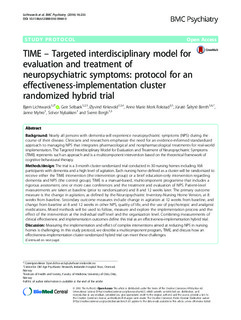| dc.contributor.author | Lichtwarck, Bjørn | |
| dc.contributor.author | Selbæk, Geir | |
| dc.contributor.author | Kirkevold, Øyvind | |
| dc.contributor.author | Rokstad, Anne Marie Mork | |
| dc.contributor.author | Saltyte Benth, Jurate | |
| dc.contributor.author | Myhre, Janne | |
| dc.contributor.author | Nybakken, Solvor | |
| dc.contributor.author | Bergh, Sverre | |
| dc.date.accessioned | 2018-05-16T11:53:30Z | |
| dc.date.available | 2018-05-16T11:53:30Z | |
| dc.date.created | 2016-07-13T13:57:49Z | |
| dc.date.issued | 2016 | |
| dc.identifier.citation | BMC Psychiatry. 2016, 16 1-12. | nb_NO |
| dc.identifier.issn | 1471-244X | |
| dc.identifier.uri | http://hdl.handle.net/11250/2498407 | |
| dc.description.abstract | Background: Nearly all persons with dementia will experience neuropsychiatric symptoms (NPS) during the course of their disease. Clinicians and researchers emphasize the need for an evidence-informed standardized approach to managing NPS that integrates pharmacological and nonpharmacological treatments for real-world implementation. The Targeted Interdisciplinary Model for Evaluation and Treatment of Neuropsychiatric Symptoms (TIME) represents such an approach and is a multicomponent intervention based on the theoretical framework of cognitive behavioural therapy. Methods/design: The trial is a 3-month cluster randomized trial conducted in 30 nursing homes including 168 participants with dementia and a high level of agitation. Each nursing home defined as a cluster will be randomized to receive either the TIME intervention (the intervention group) or a brief education-only intervention regarding dementia and NPS (the control group). TIME is a manual-based, multicomponent programme that includes a rigorous assessment, one or more case conferences and the treatment and evaluation of NPS. Patient-level measurements are taken at baseline (prior to randomization) and 8 and 12 weeks later. The primary outcome measure is the change in agitation, as defined by the Neuropsychiatric Inventory-Nursing Home Version, at 8 weeks from baseline. Secondary outcome measures include change in agitation at 12 weeks from baseline, and change from baseline at 8 and 12 weeks in other NPS, quality of life, and the use of psychotropic and analgesic medications. Mixed methods will be used to follow, measure and explore the implementation process and the effect of the intervention at the individual staff level and the organization level. Combining measurements of clinical effectiveness and implementation outcomes define this trial as an effectiveness-implementation hybrid trial. Discussion: Measuring the implementation and effect of complex interventions aimed at reducing NPS in nursing homes is challenging. In this study protocol, we describe a multicomponent program, TIME, and discuss how an effectiveness-implementation cluster randomized hybrid trial can meet these challenges. Trial registration: ClinicalTrials.gov identifier NCT02655003. Registered 6 January 2016. Keywords: dementia, neuropsychiatric symptoms, behavioural and psychological symptoms of dementia (BPSD), psychosocial interventions, nursing home, case conference | nb_NO |
| dc.description.sponsorship | Funding The trial is funded in total by a grant from the Innlandet Hospital Trust. | nb_NO |
| dc.language.iso | eng | nb_NO |
| dc.rights | Navngivelse 4.0 Internasjonal | * |
| dc.rights.uri | http://creativecommons.org/licenses/by/4.0/deed.no | * |
| dc.subject | Dementia | nb_NO |
| dc.subject | Neuropsychiatric symptoms | nb_NO |
| dc.subject | Behavioural and psychological Symptoms of dementia (BPSD) | nb_NO |
| dc.subject | Psychosocial interventions | nb_NO |
| dc.subject | Nursing home | nb_NO |
| dc.subject | Case conference | nb_NO |
| dc.title | TIME – Targeted interdisciplinary model for evaluation and treatment of neuropsychiatric symptoms : protocol for an effectiveness-implementation cluster randomized hybrid trial | nb_NO |
| dc.type | Journal article | nb_NO |
| dc.type | Peer reviewed | nb_NO |
| dc.description.version | acceptedVersion | nb_NO |
| dc.description.version | publishedVersion | nb_NO |
| dc.rights.holder | © The Author(s). 2016. This article is distributed under the terms of the Creative Commons Attribution 4.0 International License (http://creativecommons.org/licenses/by/4.0/), which permits unrestricted use, distribution, and reproduction in any medium, provided you give appropriate credit to the original author(s) and the source, provide a link to the Creative Commons license, and indicate if changes were made. The Creative Commons Public Domain Dedication waiver (http://creativecommons.org/publicdomain/zero/1.0/) applies to the data made available in this article, unless otherwise stated. | nb_NO |
| dc.source.pagenumber | 1-12 | nb_NO |
| dc.source.volume | 16 | nb_NO |
| dc.source.journal | BMC Psychiatry | nb_NO |
| dc.identifier.doi | 10.1186/s12888-016-0944-0 | |
| dc.identifier.cristin | 1367949 | |
| cristin.unitcode | 1991,9,0,0 | |
| cristin.unitname | Div Psykisk helsevern | |
| cristin.ispublished | true | |
| cristin.fulltext | original | |
| cristin.fulltext | postprint | |
| cristin.qualitycode | 1 | |

